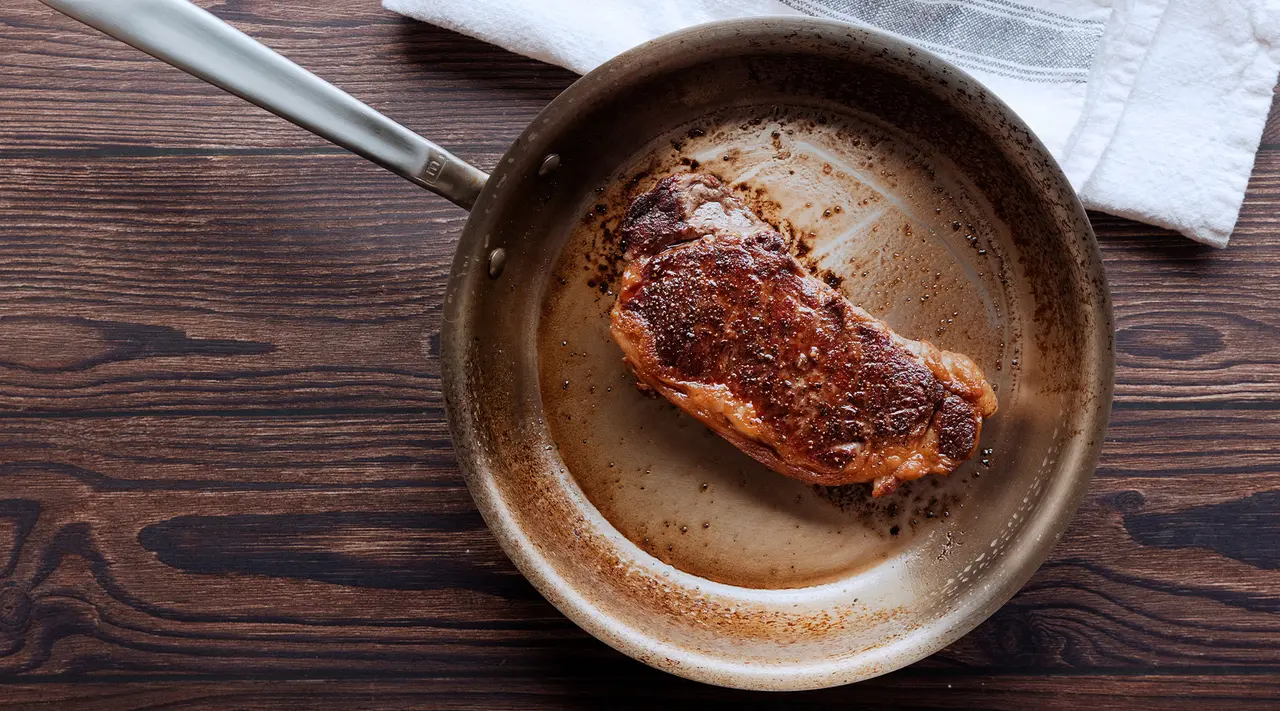When you sauté or sear ingredients, whether they’re meats or vegetables, you’ll notice some browned bits clinging to the surface of your pan. This is referred to as fond, and these are nuggets of culinary gold. Fond is not only a crucial part of creating deep flavor in many dishes—all of those bits are just morsels of flavor—but it’s also a crucial ingredient in pan sauces. So make sure you’re not discarding it.
What Is Fond?
Fond is more than a building block of flavor in many dishes, it’s the base. It makes sense then that in French, fond literally translates to “base” or “bottom”. More specifically, fond refers to the crisp, browned bits that remain at the bottom of a pan after roasting, searing, or sautéeing food.
This is often the result of a Maillard reaction, where proteins break down and carbohydrates caramelize. A crisp, browned exterior forms on the outside of your ingredients, most notably on proteins but the same occurs with vegetables as well. This crust allows your food to naturally release from the pan but some bits remain, leaving behind super-concentrated flavor. This is fond.
How to Use Fond in Cooking
The best way to release the flavor stored in fond and incorporate it back into your food is through a process called deglazing. Once you’ve finished cooking, add the liquid of your choice back into the pan to free the fond. Depending on the liquid you choose, you can control how complex the flavors in the finished dish will be. You can deglaze with water, but most cooks choose stock, cuisson, vinegar, or alcohol—typically beer, wine or cider.
You can take deglazing a step further and create a pan sauce, which also includes fat and aromatics. This is a great way to dress up a simple weeknight meal of meat and potatoes. As an example of how fond can level up your dishes, watch Chef Tracy Malechek-Ezekiel of Birdie’s in Austin make a spicy peppercorn-infused pan sauce below.
How to Make Your Fond Even More Flavorful
Now that you know what fond is and how to use it in cooking, here are some tips on boosting that built-in flavor, to help take your sauces and dishes to the next level.
Use the Right PanThe best type of pan to build up fond is Stainless Clad. You want a cooking surface that food will cling to, which eliminates Non Stick. Carbon Steel would also work, but you’ll need to be careful about what you use to deglaze. Acidic liquids like vinegar or alcohol will strip away the seasoning, so if you’re using Carbon Steel Cookware, make sure to only deglaze with stock, cuisson, or water.
However, as with most things in cooking, it depends on what you’re preparing. If you’re braising short ribs, for example, the enameled surface of our Dutch Oven is perfect for the job. For pan sauces however, we like our Stainless Clad Frying Pan or Saute Pan because of the ample surface area.
Season Your IngredientsThis one (almost) goes without saying, but it’s always important to remember to season your ingredients. If you’re working with a protein, make sure to season it on both sides. This is especially important if you’re deglazing with water, or even a less flavorful stock. Adding salt and pepper will ensure that your fond has a good base layer of flavor that you can continue adding to as you build your dish around it.
Keep an Eye on the ColorWhen you’re building fond, it’s important to make sure it doesn’t burn, which will infuse your finished dish with a bitter, acrid flavor. There are a couple ways to make sure this doesn’t happen. First, make sure you’re adding a fat with an appropriate smoke point. For example, while you can add butter to your finished pan sauce, it may not be the best choice for cooking because it will start to brown too quickly.
Second, make sure you turn off your heat as you remove your ingredients from the pan. If you let an empty pan sit over heat, even for a few minutes, you run the risk of burning your fond. Finally, color is always a good indicator if your fond is burning. You’re looking for a rich brown, not black. However, if your fond has accrued some black bits, scoop them out—a good pan sauce is likely still salvageable.
Ready to Try it for Yourself?
With its deep flavors and versatility, it’s no wonder that fond is considered an essential building block of cooking. From pan sauces to simply adding more flavor to your next saute, this is one aspect of cooking that you’ll likely find yourself using, and appreciating, almost every day. Try it for yourself in Chef Tracy Malechek’s recipe for Minute Steak.























